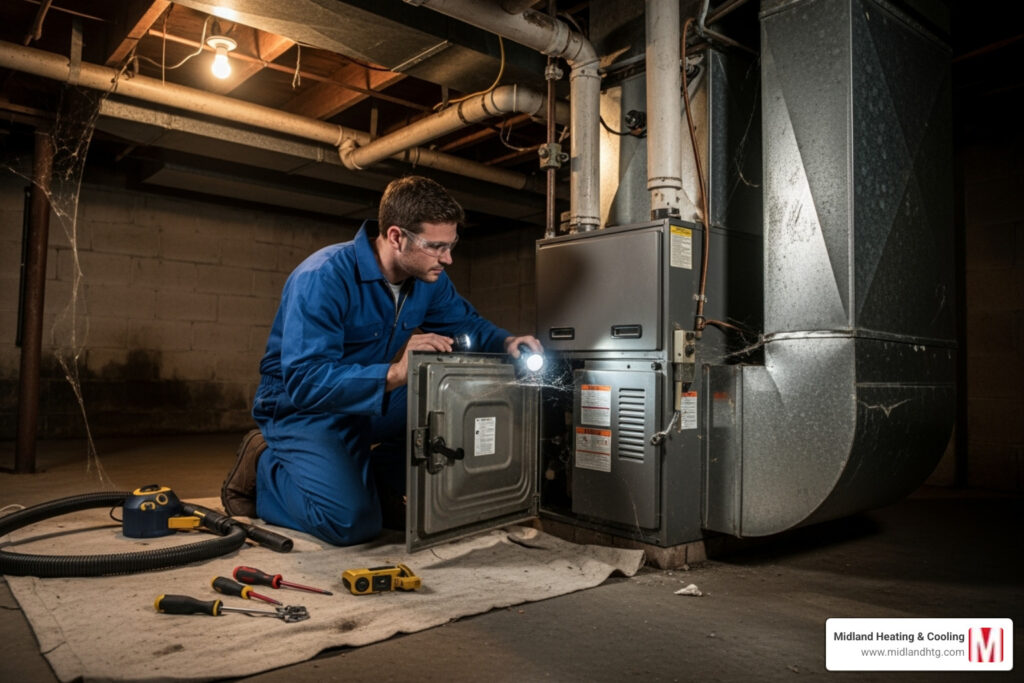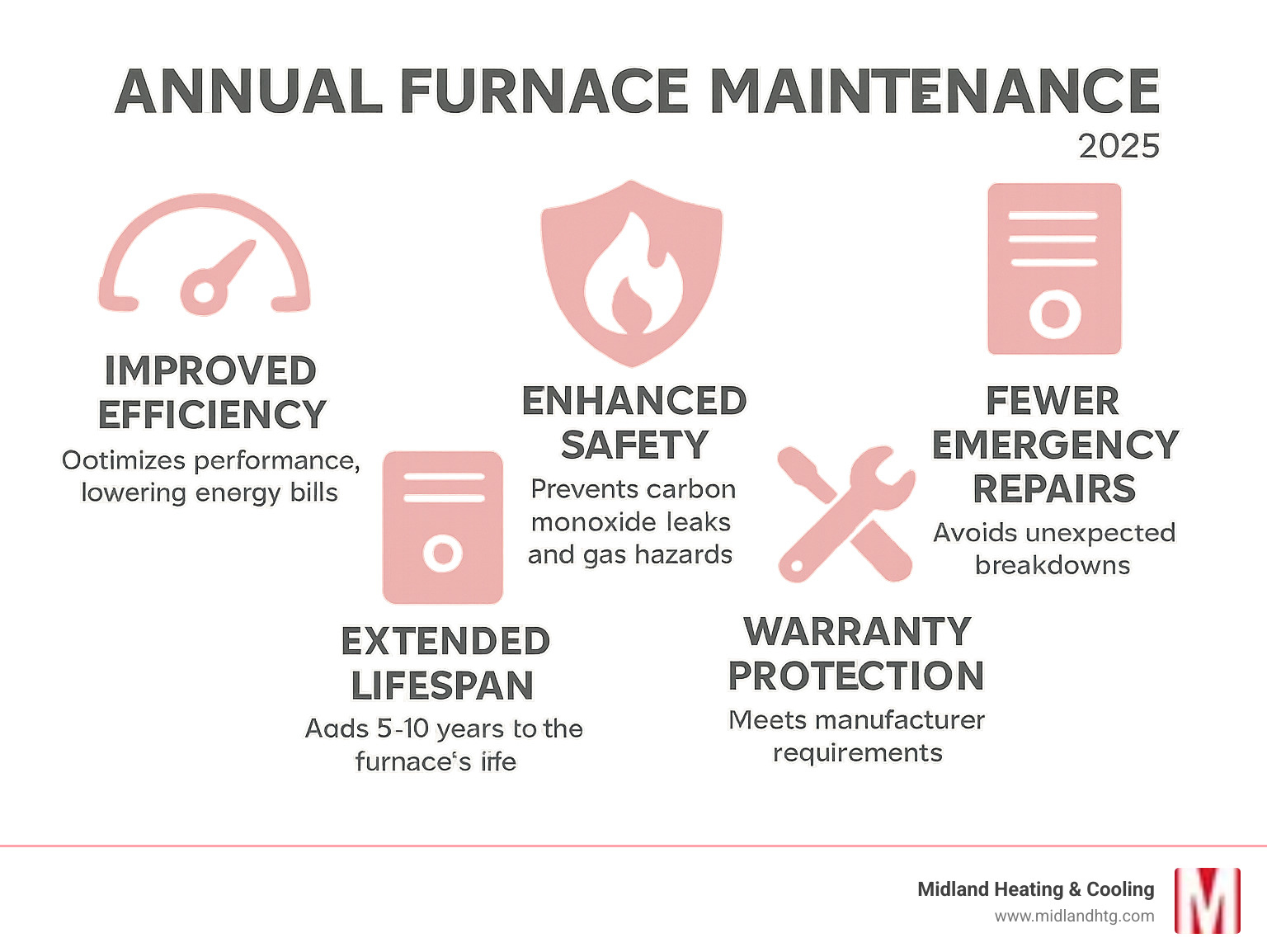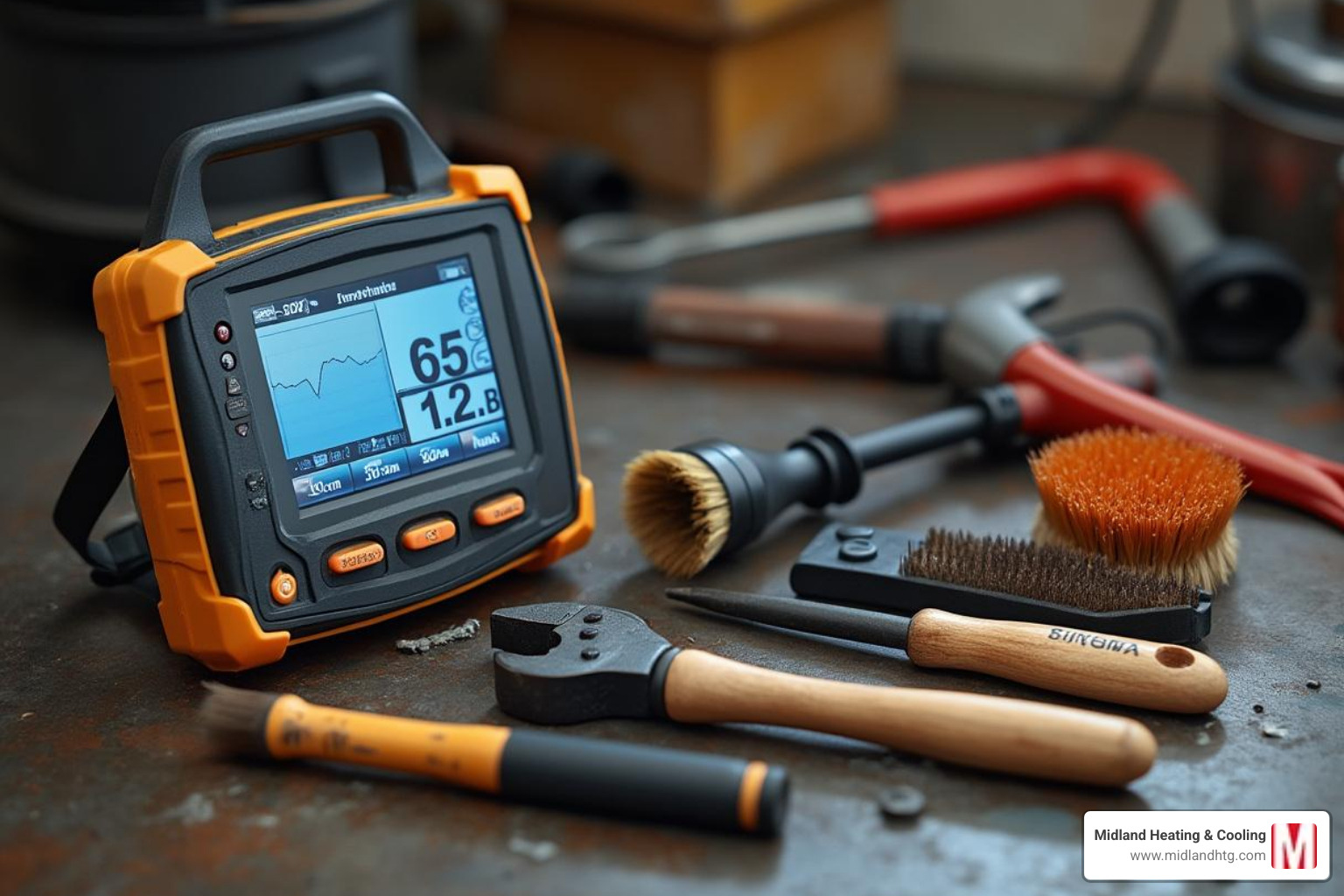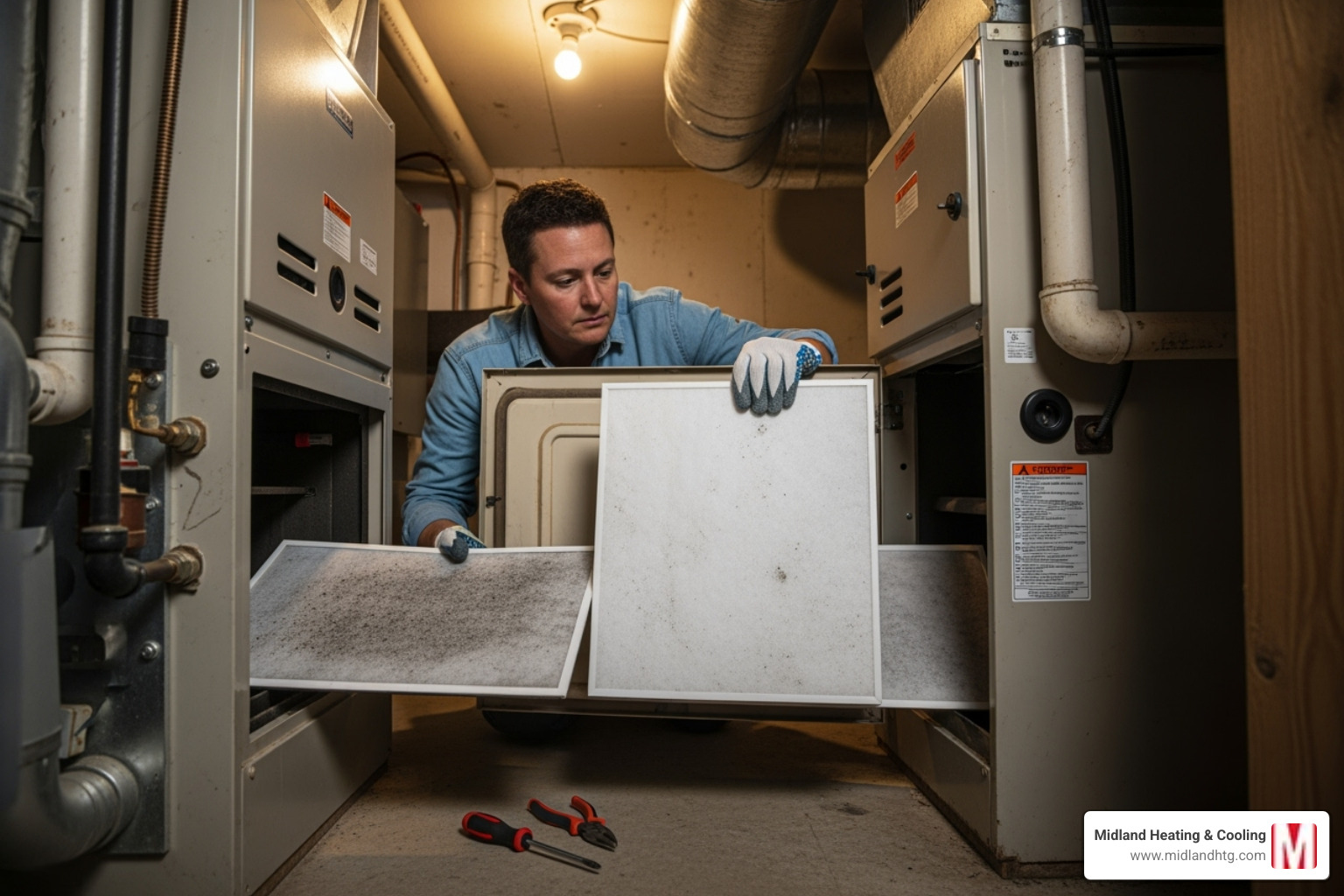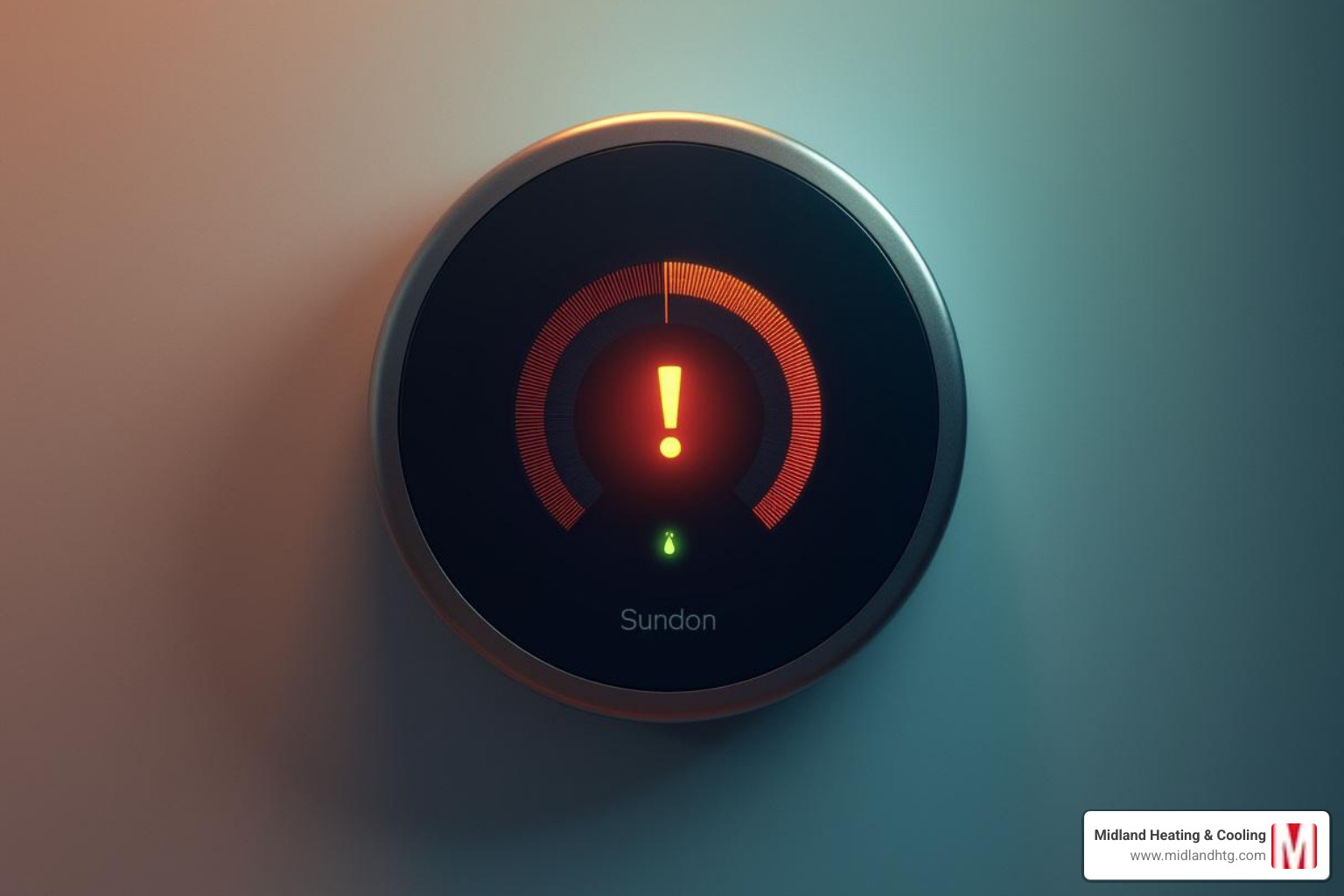Why Annual Furnace Maintenance is Essential for Twin Cities Homeowners
Annual furnace maintenance is a yearly service performed by HVAC professionals to inspect, clean, and tune up your heating system. This preventive care ensures your furnace runs safely and efficiently throughout the winter months.
What Annual Furnace Maintenance Includes:
- Professional inspection of heat exchanger, burners, and electrical connections
- Cleaning of blower motor, flame sensor, and internal components
- Safety checks for gas leaks, carbon monoxide, and proper ventilation
- Performance testing of thermostat calibration and airflow
- Lubrication of moving parts and tightening of loose connections
The industry standard recommendation is to have your furnace serviced at least once per year, ideally in early fall before the heating season begins. This simple step can extend your furnace’s lifespan by 5-10 years and reduce the likelihood of costly emergency repairs.
Regular maintenance helps prevent dangerous situations like carbon monoxide leaks and ensures your system operates at peak efficiency. A well-maintained furnace can last 15-30 years, while a neglected system may fail in just 10 years.
For Twin Cities homeowners facing harsh winters, this annual investment becomes even more critical. When temperatures drop below freezing, the last thing you want is a furnace breakdown that leaves your family in the cold.
The Undeniable Benefits of Regular Furnace Care
Annual furnace maintenance is one of the smartest investments you can make for comfort, safety, and your wallet. Serving Twin Cities families since 1950, we’ve seen preventive care save homeowners thousands of dollars and prevent stressful winter breakdowns.
Improved Efficiency and Lower Energy Bills
Dust and debris force your furnace to work harder and burn more fuel. During maintenance, we clean critical components and calibrate your system so it converts fuel to heat efficiently. Many customers notice lower utility bills right away. For more on how efficiency impacts costs, see more info about energy savings.
Improved Safety for Your Family
Furnaces burn fuel, so safety checks are essential. We test for carbon monoxide, inspect for gas leaks, verify proper ventilation, and tighten electrical connections that can become fire hazards. We also examine the heat exchanger for cracks that could allow dangerous gases into your home.
Fewer Breakdowns and a Longer Lifespan
Annual furnace maintenance catches small issues early, helping you avoid emergency repairs and extending equipment life by 5 to 10 years. Clean, lubricated parts run smoothly and last longer, delaying the need for a costly replacement. For help spotting issues early, see our guide on signs you need furnace repair.
What to Expect from Your Annual Furnace Maintenance Service
When you schedule annual furnace maintenance with us, you get a comprehensive health checkup for your furnace, saving you from middle-of-winter emergencies. Our certified technicians use specialized tools and experience to ensure your family stays warm and safe throughout Minnesota’s brutal winters.
You might wonder what you can handle yourself versus what needs a professional. We encourage homeowners to take an active role in their system’s care. Here’s the breakdown:
| DIY Tasks (Homeowner) | Professional Tasks (Technician) |
|---|---|
| Change air filter | Clean and inspect burners and flame sensor |
| Clean air vents and registers | Inspect and clean heat exchanger |
| Keep furnace area clear | Check and tighten electrical connections |
| Test smoke and CO detectors | Lubricate moving parts (e.g., blower motor) |
| Monitor thermostat function | Test safety controls and gas pressure |
| Listen for unusual noises | Inspect flue pipe and ductwork |
| Observe furnace flame color | Calibrate thermostat |
| Vacuum furnace interior | Measure temperature rise |
| Check humidifier pad | Perform carbon monoxide testing |
While we encourage DIY tasks, the professional side requires specialized knowledge and equipment for complex and potentially dangerous components.
The Professional Tune-Up Checklist
When our technicians arrive for your annual furnace maintenance, they bring years of training and a systematic approach to ensure nothing is overlooked.
Our tune-up starts with blower motor cleaning and inspection. Dust buildup on the blower wheel forces your system to work overtime. We clean it thoroughly and check for proper airflow.
Next is the burner and flame sensor inspection. We clean the burner, crossover, ignitor, and the crucial flame sensor. A dirty flame sensor is a common point of failure and can’t properly verify a safe flame.
The heat exchanger check is critical for your safety. This component separates combustion gases from your breathing air. We carefully inspect it for cracks or holes that could leak dangerous carbon monoxide into your home.
Electrical wiring tightening might sound mundane, but loose connections are like ticking time bombs. They can cause system failures or even fires. We inspect every connection and tighten anything that’s gotten loose over the year.
For gas furnaces, gas pressure adjustment ensures optimal combustion. We check and adjust the gas valve, measuring manifold pressure to keep it in that sweet spot between 3.2 WC and 3.7 WC. It’s all about efficiency and longevity.
Lubricating moving parts keeps everything running smoothly and quietly. Think of it as giving your furnace a spa day – reducing friction and preventing premature wear on components like the blower motor and bearings.
Thermostat calibration ensures your home stays exactly as comfortable as you want it. We test both the thermostat and furnace switch to make sure they’re communicating properly and accurately controlling your home’s temperature.
We also perform pilot system inspection for older furnaces, ventilation system checks to ensure safe venting, safety control testing to verify all protective systems work correctly, and comprehensive performance testing including temperature readings and carbon monoxide testing.
This thorough approach follows industry best practices, including those outlined in the Energy Star Maintenance Checklist.
Simple DIY Tasks for Homeowners
Between our professional visits, there are several simple things you can do to keep your furnace happy. These tasks don’t require special tools or training – just a little attention and care.
Checking and cleaning air vents and registers is like clearing the highways for warm air to travel through your home. Make sure furniture, rugs, or curtains aren’t blocking these pathways. A quick vacuum of the vents removes dust that would otherwise circulate throughout your house and eventually clog up your furnace.
Keeping the furnace area clear gives your system room to breathe. We recommend at least three feet of clearance on all sides. Never store paint, cleaning supplies, or other combustible materials nearby – your furnace generates heat, and safety should always come first.
Testing smoke and CO detectors is your family’s early warning system. Test them monthly and replace batteries twice a year (we suggest doing it when daylight saving time changes – easy to remember!). These devices typically last 5-10 years, so check the manufacture dates periodically.
How Often Should a Furnace Filter Be Replaced?
You can’t change your furnace filter too often, but you can definitely wait too long. A clean filter is your furnace’s best friend and crucial for your indoor air quality.
The general rule is to check monthly and replace every three months maximum. Never let a filter go more than a year – that’s asking for trouble.
Pet owners need to be more vigilant. One pet means changing every 60 days, while multiple furry family members might require changes every 20-45 days. Pet dander is sneaky and accumulates faster than you’d think.
Allergy sufferers should lean toward the more frequent end – every 20-45 days keeps indoor air quality at its best. During heavy system use (hello, Minnesota winter!), filters work overtime and need more frequent attention.
When shopping for filters, you’ll see MERV ratings ranging from one to sixteen. Higher numbers capture more particles but may need more frequent replacement. For detailed guidance on choosing the right rating, check out more about MERV ratings.
Decoding the Costs and Best Time to Schedule
How Much Does Professional Furnace Maintenance Typically Cost?
Most homeowners invest between $75 and $200 for a comprehensive annual tune-up. Price varies by furnace type, age, and how much cleaning or adjustment is needed. Compared to emergency repairs, which can run hundreds or even thousands of dollars, preventive maintenance is a fraction of the cost and often pays for itself through fewer breakdowns and lower energy bills. See more details in cost information from Angi.
When Is the Best Time of Year for a Tune-Up?
Schedule in early fall before you rely on your heat. You’ll avoid the first-cold-snap rush, get better appointment options, and have time to address issues while the weather is mild. If winter has already arrived, it’s still worth doing—late is better than never. For seasonal tips, visit our HVAC Blog.
Warning Signs: When Your Furnace Needs Immediate Attention
Even with regular annual furnace maintenance, your system can signal trouble. Catching issues early helps you avoid cold nights, safety risks, and expensive repairs.
What to Listen and Smell For
A healthy furnace runs with a soft whoosh and gentle hum. Banging or rattling can indicate loose parts, blower issues, or even a cracked heat exchanger. Whistling or screeching often points to worn belts or failing motor bearings. A rotten egg smell suggests a natural gas leak—leave your home immediately, avoid switches or flames, and call your gas supplier or 911 from a safe location. A brief dusty odor at first startup can be normal, but persistent burning smells may signal electrical problems or overheating. Learn more in our guide on common furnace repair issues and solutions.
Performance Issues to Watch Out For
Short cycling (frequent starts and stops) wastes energy and wears parts; common causes include restricted airflow or overheating. Unexplained increases in energy bills, uneven heating between rooms, and weak airflow are all red flags. For older units, a yellow or flickering pilot light indicates incomplete combustion and potential carbon monoxide production. Difficulty starting or no heat at all warrants a professional visit. In the Twin Cities, our team can help with fast, expert furnace repair.
Frequently Asked Questions about Annual Furnace Maintenance
We get it – homeowners have questions about annual furnace maintenance. After decades of serving Twin Cities families, we’ve heard just about every concern imaginable. Let’s tackle the most common ones to help you understand why this yearly investment is so important for your home’s comfort and safety.
Is annual furnace maintenance really necessary every year?
Absolutely, yes! We know it might seem like an extra expense, especially when your furnace appears to be running just fine. But here’s the thing – most furnace manufacturers actually require annual maintenance by a qualified HVAC professional to keep your warranty valid. Skip it, and you could void your coverage, leaving you responsible for repairs that would otherwise be covered.
Beyond protecting your warranty, annual furnace maintenance serves as your home’s safety net. Think of it like getting an annual physical at the doctor – you might feel fine, but that checkup can catch problems before they become serious.
Regular maintenance ensures your furnace operates safely by checking for carbon monoxide leaks, gas leaks, and electrical hazards that can develop gradually over time. It keeps your system running efficiently, preventing energy waste that drives up your utility bills. Most importantly, it catches those small issues before they turn into major breakdowns during the coldest Minnesota nights.
The bottom line? A well-maintained furnace can last 15-30 years, while a neglected system might barely make it to 10 years. That yearly service appointment is protecting both your family’s safety and your long-term investment.
Can I perform furnace maintenance myself?
We absolutely encourage homeowners to take an active role in caring for their furnaces! There are several important tasks you can and should handle yourself. Changing your air filter regularly, keeping the area around your furnace clear of clutter, cleaning air vents, and listening for unusual sounds are all valuable contributions to your system’s health.
However – and this is crucial – there’s a clear line between what homeowners can safely do and what requires professional expertise. Our certified technicians have specialized training, tools, and experience to handle the complex and potentially dangerous aspects of furnace maintenance.
Professional tasks include:
- Inspecting the heat exchanger for dangerous cracks that could leak carbon monoxide
- Working with gas lines and electrical connections safely
- Testing and calibrating safety controls that protect your family
- Measuring gas pressure and combustion efficiency with specialized equipment
- Cleaning internal components like burners and flame sensors
Attempting these tasks without proper training can be dangerous and may actually cause more harm than good. Your DIY efforts are valuable and appreciated, but they work best alongside professional annual furnace maintenance to ensure your system receives comprehensive care.
How long can a furnace last with regular maintenance?
This question really gets to the heart of why annual furnace maintenance is such a smart investment! The difference between a well-maintained furnace and a neglected one is truly remarkable.
A furnace that receives consistent professional care can easily last 15 to 30 years. We’ve seen some exceptionally well-maintained systems exceed even this impressive range. Regular maintenance reduces wear and tear on components, ensures everything operates smoothly, and catches small problems before they cause major damage.
On the flip side, a furnace that doesn’t receive regular attention might struggle to reach even 10 years of service. Without proper care, components work harder than they should, small issues snowball into big problems, and the entire system ages prematurely.
The math is pretty compelling when you think about it. Investing in yearly maintenance can literally add 5 to 10 years (or more) to your furnace’s life. That means delaying the significant expense of a full system replacement while enjoying reliable, efficient heating throughout those extra years.
Regular annual furnace maintenance isn’t just about keeping your home comfortable this winter – it’s about maximizing the value of your heating system investment for decades to come.
Conclusion
When Minnesota temperatures plummet, your furnace is your family’s lifeline. Annual furnace maintenance is a proactive investment that delivers lower energy bills, fewer breakdowns, longer equipment life, and protection from carbon monoxide risks.
Midland Heating & Cooling has kept Twin Cities homes comfortable since 1950. Our certified technicians focus on safety, efficiency, and reliable performance—so your heat stays on when you need it most.
Ready for worry-free winter comfort? Our comprehensive HVAC Maintenance Plan Minneapolis MN is built for Twin Cities weather and your peace of mind.


